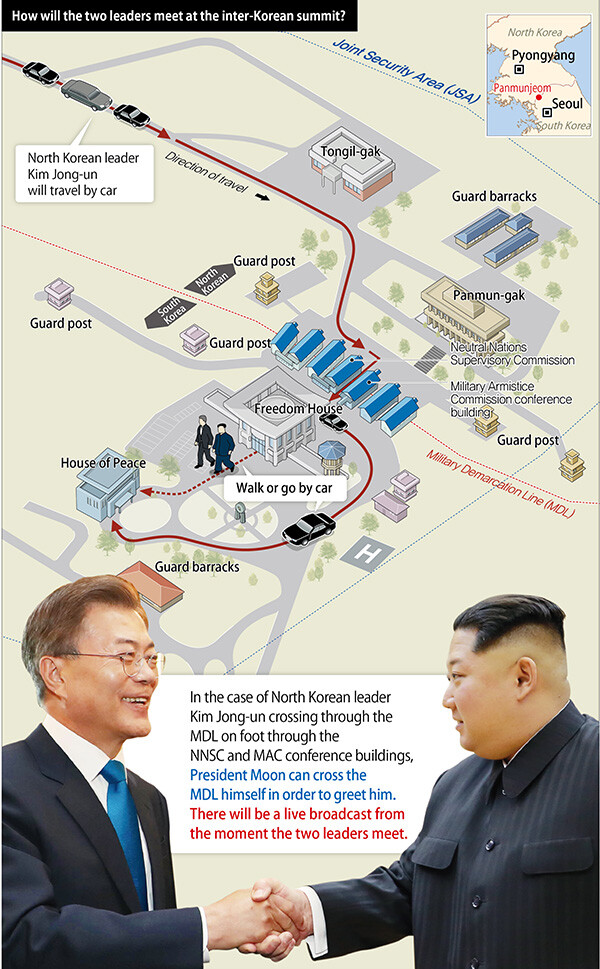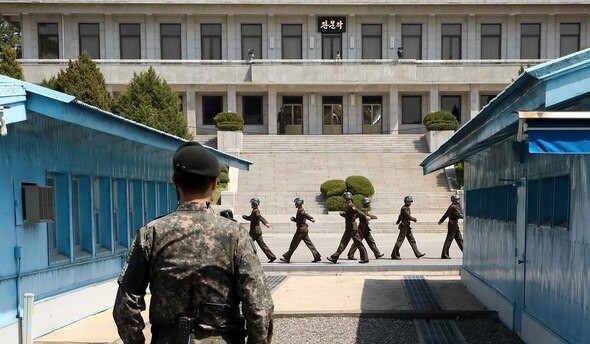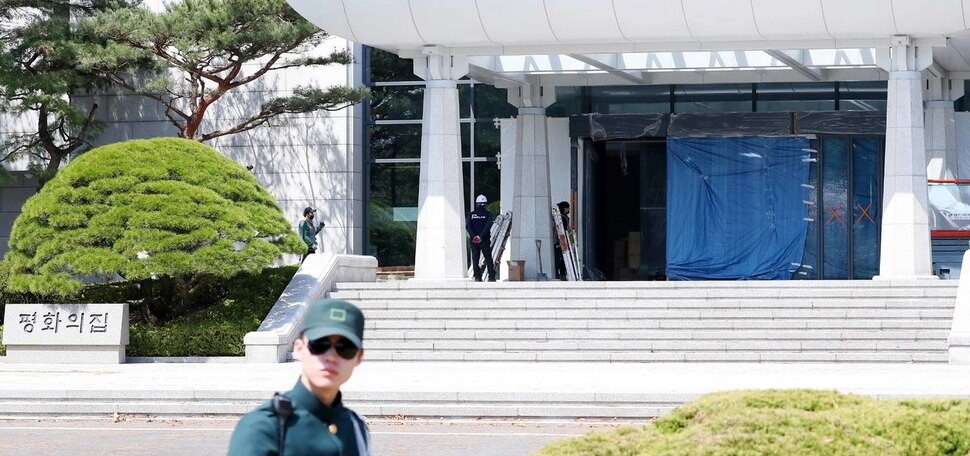hankyoreh
Links to other country sites 다른 나라 사이트 링크
[Reportage] An in-depth look at the Panmunjeom Joint Security Area

It was a warm spring day as those of us in the Blue House press corps headed for Panmunjeom on April 18. The white blossoms of the cherry trees had already burst forth in the relaxing sunshine. In the Demilitarized Zone (DMZ) south of the Military Demarcation Line (MDL), dandelions bloomed along the ridges between the rice paddies farmed by the residents of the Daeseong-dong Freedom Village.
The access road that leads into the Joint Security Area (JSA), where Panmunjeom is located, is part of Route 1. The road begins in Mokpo, South Jeolla Province, and passes through Seoul, Gaesong, and Pyongyang on its way to its terminus in Sinuiju. But beyond Panmunjeom we cannot go.
Our bus, which left from Camp Bonifas, a military post shared by the ROK military and the United States Forces Korea, covered the 2.4-km distance to Panmunjeom in just under ten minutes. The camp was named after Captain Arthur G. Bonifas, who was killed by North Korean soldiers in the Axe Murder Incident of 1976. President Moon Jae-in has a connection with this incident. He was in the service at the time, and his airborne unit was assigned to cut down the eastern cottonwood trees that blocked the view from the south checkpoint in Panmunjeom.
The dominant color at Panmunjeom is sky blue. Here and there are signs in this symbolic color of the United Nations Command. The buildings that stand right on the Demarcation Line and house the meeting room of the Neutral Nations Supervisory Commission and the main and small meeting rooms of the Military Armistice Commission are also painted sky blue. Panmunjeom is not very big. It measures only 800 meters from east to west and 400 meters from north to south. The layout is symmetrical, with Freedom House and Peace House standing to the south of the Demarcation Line and Panmun Pavillion on the north side.
Panmunjeom's former name was Neolmun-ri (meaning "Wooden Door Village"). The JSA Visitor Center explains it this way: "A small, quiet village called Neolmun-ri originally stood at the site of Panmunjeom. During the Korean War, truce talks were held at Naebongjang, in Gaesong, but because of the danger of frequent combat nearby, the talks were moved to Neolmun-ri on September 6, 1951. In order to make it easier for representatives of the Chinese forces to find the place, they told them to look for the sign on a neighboring shop, which read Panmunjeom in Chinese characters. The pan character means 'wooden board,' mun means 'door,' and jeom means 'shop.'"
Memories of the division between north and south and of the armistice negotiations live on at Panmunjeom. They began in tents set up here, and the meetings were held 765 times over a period of two years. Since the first North-South Red Cross talks in 1971, 365 meetings, large and small, have been held here.
During our visit, the final stages of renovation work were going on at Peace House, where the summit will be held on Apr. 27. This is about 300 meters from the MDL and only about 200 meters from the place where the North Korean soldier Oh Cheong-seong was shot while fleeing to South Korea in November 2017. A temporary blue screen blocks the main entrance of the building. With only two or three workers on the site, the construction appears to be almost finished.

A building constructed to handle South-North liaisons
Peace House is a four-story building constructed in 1998 to handle South-North liaisons. It has been used for inter-Korean meetings and discussions concerning military, politics, economics, and sports. Off the first floor lobby are a pressroom and various amenities, and on the second floor there are meeting rooms, offices, and a waiting room. The third floor houses the Liaison Office and the liaison of the South Korean Red Cross as well as a large meeting hall. There is an observation deck and a multipurpose area on the fourth floor.
There is also a direct telephone line connecting the two sides installed in Peace House. The historic summit between South Korean President Moon and North Korean Workers' Party Chairman Kim Jong-un will be held here on the second floor. Their official luncheon and dinner will also likely take place in this building.
Standing in front of Freedom House, which is about 100 meters from Peace House, one can imagine North Korean leader Kim's approach. The MDL is only about five meters from Freedom House. There is no barbed-wire fence or wall on the line the divides the two sides. There is only a concrete slab 50cm wide and 5cm high, and straddling the line are the buildings housing the commission meeting rooms mentioned above.
Between the three blue buildings are two walkways about three meters wide, which is enough for three adults to stand abreast. The walkways are covered with sand to the north and gravel to the south. Kim will cross the concrete slab as he enters the south side, where he will be welcomed by the extended hand of President Moon. The eyes and ears of the world will be focused on them.
On April 18 at the second working-level talks on protocol, security, and media coverage, the two sides agreed to allow worldwide live broadcasts of the major events, beginning with the very first handshake.
If Kim decides to ride across rather than walk, he will use the road that goes around the the small meeting room of the Military Armistice Commission. This is the same road used by the late Hyundai Chairman Jung Ju-yung's convoy of trucks to deliver 500 head of cattle to North Korea in June 1998. Currently the road is unpaved, with weeds sprouting here and there. A bar blocks the entrance to the road. A Blue House official says, "It has not yet been decided how Chairman Kim will cross the Demarcation Line."
A week from now, Panmunjeom will once again become the site of discussions on ending war and establishing lasting peace, reenacting the role it played during those armistice talks of 67 years ago.

On April 17, Im Jong-seok, chairman of the Inter-Korean Summit Preparatory Committee, said, "One important part of the agenda for this summit is to make inter-Korean talks at Panmunjeom an ongoing process. The talks will go beyond just dealing with issues between South Korea and the North, providing an opportunity to solve problems in relations between the United States and North Korea as well and could develop into talks that have a significance even greater than that of the Malta Summit."
It’s an expression of the hope that Panmunjeom will go down as a symbolic setting that changed world history – comparable to the Mediterranean island nation of Malta, where the US and Soviet leaders met in 1989 to lay the foundation for ending the Cold War.
After the harshness of the past winter, spring has come to Panmunjeom as well. It’s the right season for Panmunjeom’s transformation: from the place where the pain of division began to a place of peace. A week from today, the doors of the Peace House will open.
By Seong Yeon-cheol, staff reporter
Please direct questions or comments to [english@hani.co.kr]

Editorial・opinion
![[Column] Season 2 of special prosecutor probe may be coming to Korea soon [Column] Season 2 of special prosecutor probe may be coming to Korea soon](https://flexible.img.hani.co.kr/flexible/normal/500/300/imgdb/original/2024/0426/3317141030699447.jpg) [Column] Season 2 of special prosecutor probe may be coming to Korea soon
[Column] Season 2 of special prosecutor probe may be coming to Korea soon![[Column] Park Geun-hye déjà vu in Yoon Suk-yeol [Column] Park Geun-hye déjà vu in Yoon Suk-yeol](https://flexible.img.hani.co.kr/flexible/normal/500/300/imgdb/original/2024/0424/651713945113788.jpg) [Column] Park Geun-hye déjà vu in Yoon Suk-yeol
[Column] Park Geun-hye déjà vu in Yoon Suk-yeol- [Editorial] New weight of N. Korea’s nuclear threats makes dialogue all the more urgent
- [Guest essay] The real reason Korea’s new right wants to dub Rhee a founding father
- [Column] ‘Choson’: Is it time we start referring to N. Korea in its own terms?
- [Editorial] Japan’s rewriting of history with Korea has gone too far
- [Column] The president’s questionable capacity for dialogue
- [Column] Are chaebol firms just pizza pies for families to divvy up as they please?
- [Column] Has Korea, too, crossed the Rubicon on China?
- [Correspondent’s column] In Japan’s alliance with US, echoes of its past alliances with UK
Most viewed articles
- 1‘We must say no’: Seoul defense chief on Korean, USFK involvement in hypothetical Taiwan crisis
- 2N. Korean delegation’s trip to Iran shows how Pyongyang is leveraging ties with Moscow
- 3[Column] Season 2 of special prosecutor probe may be coming to Korea soon
- 4‘Weddingflation’ breaks the bank for Korean couples-to-be
- 5[Column] Has Korea, too, crossed the Rubicon on China?
- 6[Editorial] New weight of N. Korea’s nuclear threats makes dialogue all the more urgent
- 7[Reportage] On US campuses, student risk arrest as they call for divestment from Israel
- 8Korea sees more deaths than births for 52nd consecutive month in February
- 9[Column] Park Geun-hye déjà vu in Yoon Suk-yeol
- 10[Guest essay] The real reason Korea’s new right wants to dub Rhee a founding father